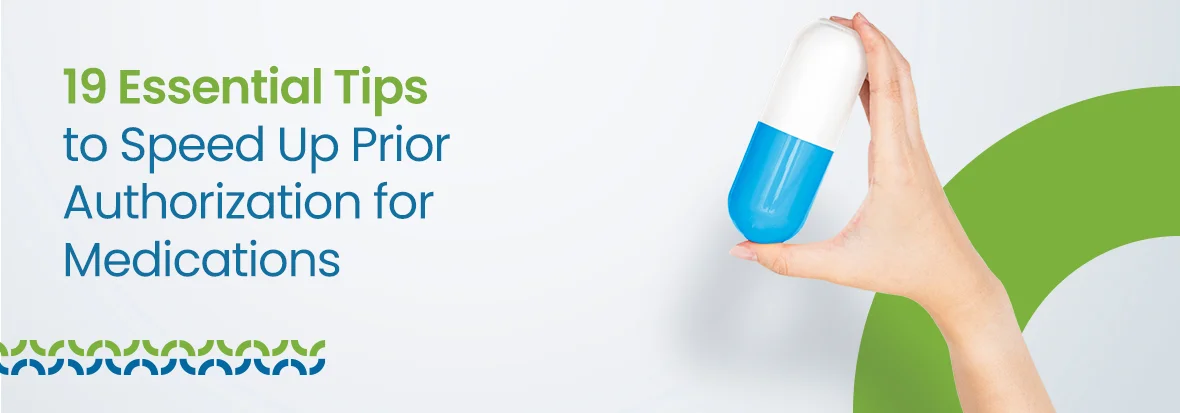Prior authorization can be a challenging and lengthy process, particularly when it comes to medications. However, it plays a crucial role in confirming that a prescribed medication is medically necessary, suitable for the patient’s condition, and cost-effective.
The good news is that there are methods to streamline the process. This guide outlines 19 effective tips to accelerate prior authorization for medications. Additionally, we will address common questions related to medication prior authorization.
What is Prior Authorization?
Your health insurance provider may require your doctor to obtain a prior authorization (PA), sometimes referred to as “pre-authorization,” before covering the costs of a prescription, medical device, or procedure.
A Utilization Management Approach
Insurance companies implement prior authorization as part of a utilization management strategy, evaluating the medical necessity and cost implications of specific treatments, tests, and medications prescribed by healthcare providers before they are approved.
Effective Use of Healthcare Benefits
Prior authorization helps avoid unnecessary spending on costly treatments when more affordable alternatives may be effective. Insurance providers may suggest more affordable healthcare providers or facilities to their members.
It also ensures that patients can access essential but expensive procedures, treatments, durable medical equipment (DME), and specialty medications, potentially preventing extended hospital stays.
The Prior Authorization Process
The prior authorization request process involves several steps, typically taking anywhere from a few days to several weeks, depending on the complexity of the request and the healthcare facility’s capacity. Here’s how the process generally unfolds:
- The healthcare provider determines if a patient requires a procedure, test, medication, or equipment.
- The provider checks the health plan’s policy or prescription guidelines to see if prior authorization is needed for the prescribed treatment. The provider must then complete a prior authorization request form to confirm the medical necessity.
- Since clinical and billing systems are rarely integrated, healthcare providers manually review the prior authorization rules specific to the patient’s insurance plan. These guidelines are usually in paper, PDFs, or available on payer websites. The policies vary across insurers and can differ from plan to plan.
- If prior authorization isn’t required, the healthcare provider can submit the claim directly to the insurance provider. However, this does not guarantee approval. If prior authorization is necessary, the provider must research the appropriate CPT codes related to the requested treatment.
- A payer-assigned number must be included in the final claim, corresponding to the prior authorization request. These steps are often carried out manually through phone calls, emails, and document submissions.
- The healthcare provider must maintain communication with the insurer until the prior authorization request is approved, transferred, or denied.
How Long Does Prior Authorization Take?
The time required for an insurance company to process a prior authorization request depends on factors like the complexity of the request, the type of treatment or medication, and the insurer’s internal processes and workload. On average, the decision can take anywhere from a few days to several weeks.
For urgent or time-sensitive requests, some insurers offer expedited processes, which can result in a decision within hours or a few days. It’s best to consult your insurance provider to understand their typical processing times and any specific steps or requirements involved in the prior authorization process.
How to Make a Prior Authorization Request?
What requires prior authorization can vary between health plans, and your doctor may not be aware that a prescription or test requires it under your specific plan.
Some health plans provide a member account or patient portal where you can check if your medication or procedure is covered fully, partially, or not at all. You can also find pricing information and any restrictions or requirements associated with your plan.
What Happens After a Request is Made?
When your insurance company receives the prior authorization request from your doctor, one of the following five outcomes may occur:
- Your request is approved.
- Your request is denied.
- The insurance company asks for additional information.
- The insurer recommends a more affordable, equally effective treatment before approving your original request.
- If denied, you can appeal the decision.
Is Prior Authorization Required in Emergencies?
No, prior authorization is not required for emergency treatments. However, the coverage for urgent medical expenses will depend on the terms of your health plan.
Who Handles Prior Authorization?
Healthcare providers or the patient’s representatives typically submit prior authorization requests to the insurance company. Providers are usually the best source of information for the requested treatment or medication and can offer the clinical details necessary to support the request.
Patients or their representatives can also reach out to their insurance company with the relevant information to initiate the prior authorization process. It’s important to confirm with the healthcare provider whether they have the required details and are willing to submit the request.
How to Obtain Prior Authorization: A Step-by-Step Guide
The prior authorization process may vary based on the insurance provider, so it’s important to contact your insurer directly for their specific requirements. If you find that prior authorization is needed, follow these steps:
Step 1: Verify Patient Eligibility
Before submitting a prior authorization request, confirm that the patient qualifies for the treatment or medication under their insurance plan. Ensure that the patient’s coverage includes the proposed treatment or medication and check for any restrictions.
Step 2: Determine If Prior Authorization Is Required
Not all services or medications need prior authorization. Check with the insurance provider to see if the proposed treatment requires approval beforehand.
Step 3: Locate and Complete the Required Forms
Insurance companies typically have specific forms for the prior authorization process. Find the necessary forms on the insurer’s website or contact them directly. These forms usually require patient information, details about the requested treatment or medication, and any relevant clinical documentation.
Step 4: Submit the Request
Once the forms are completed, submit them to the insurance provider along with any supporting documents. You can submit the request through the insurer’s website, by fax, or by mail.
Step 5: Track the Authorization Status
After submitting the prior authorization request, follow up to check the status. You can do this by calling the insurer or checking online. Depending on their procedures and workload, the decision may take anywhere from a few days to several weeks.
6 Common Challenges in the Prior Authorization Process
These obstacles can cause delays, so it’s important to identify and address them before focusing on ways to expedite the process.
- Rising number of prior authorization requests for medications
- Shortage of qualified staff members
- Frequent changes to payer requirements
- Labor-intensive process with multiple steps involved
- High workloads and stress among healthcare professionals
- Insufficient transparency and understanding of the process
Eliminate authorization errors before they cost you
How to Speed Up Prior Authorization for Medication: 19 Key Tips and Considerations
The prior authorization (PA) process can be time consuming, but there are strategies to expedite it. Here are 19 essential tips to help speed things up and ensure smoother approvals:
Provide Accurate and Complete Patient Information
One common cause of delays in the prior authorization process is submitting incomplete or incorrect patient details. Even small mistakes, such as incorrect health ID numbers or misspelled names, can trigger delays or even automatic denials. So, ensure you have all the patient’s clinical data, test results, and documentation ready when submitting the PA request.
Keep a Master List of Procedures Requiring Authorization
Maintain an up-to-date list of all procedures that need prior authorization. This will help ensure that the correct procedures are submitted on time and that the process is efficient.
Document Reasons for Prior Authorization Rejections
Keep track of why certain requests are rejected. Understanding the reasons can help prevent future rejections and increase the chances of approval next time.
Double-Check CPT Codes
Verify that all the correct codes for the requested treatment or medication are included. Using the wrong codes can cause the request to be denied or delayed.
Stay Informed with Payer Newsletters
Subscribe to updates from insurance providers to stay informed about changes to their prior authorization requirements and coverage.
Keep Up with Industry Changes
The healthcare industry is constantly evolving, so it’s crucial to stay current on updates that may affect the prior authorization process.
Assign Dedicated Staff to Handle Prior Authorizations
Designate a specific team or individual to handle prior authorizations. Consistency and expertise can greatly streamline the process.
Organize Authorizations in One Central Location
Track each authorization request and its status in a centralized location to avoid duplication of efforts and ensure nothing is overlooked.
Utilize Technology to Streamline the Process
Take advantage of software tools designed to automate the prior authorization process, saving both time and improving accuracy.
Keep a List of Payor Contacts
Maintain a list of key contacts at each insurance provider for easy access and quicker communication.
Maintain Comprehensive Clinical Records
Ensure all relevant clinical data is easily accessible and up to date to support your prior authorization requests.
Document All Communications with Payors
Keep a record of every interaction with the insurance company, including dates, names, and key details, to monitor the progress of your request.
Develop a Follow-Up Plan
Create a plan for following up on authorizations to ensure timely completion and avoid unnecessary delays.
Handle Authorizations Methodically
Approach each authorization systematically and prioritize them according to urgency, working through them in an organized manner.
Request an Estimated Turnaround Time
Contact the insurance company and ask for an estimated turnaround time for the prior authorization process. This will help you manage expectations and prepare accordingly.
Master the Prior Authorization Process
Take the time to learn the ins and outs of the prior authorization procedure. Familiarity with the process can reduce frustration and help save time and resources.
Avoid Last-Minute Requests
Submit prior authorization requests well in advance of when treatment is needed. Waiting until the last minute can result in delays that impact care.
Maintain Transparency and Open Communication
Ensure clear and regular communication with the insurance company. This fosters a positive relationship and can help avoid misunderstandings during the prior authorization process.
Appeal Denied Requests Quickly
If your request is denied, review the reasons and submit an appeal as soon as possible. Be sure to provide any additional information or clarifications requested by the insurer.
Streamline Your Prior Authorization Process Today
Healthcare providers often face challenges when justifying and following up on prescribed treatments with insurance companies. This guide aims to help both patients and providers simplify the prior authorization process, which, though challenging, is essential for ensuring the proper allocation of medical resources.
The time spent on “paper-chasing” prior authorization requests can create tension between providers and payers, ultimately leaving patients underserved. According to the American Medical Association (AMA), physicians spend 16 hours a week on authorizations, with nearly 90% reporting delays in care.
Let MedCare MSO Help Clear Your Backlog
Freeing up these hours for doctors can improve patient care, reduce administrative stress, and strengthen relationships with payers. One effective solution to reduce the administrative burden is to outsource request verification to qualified professionals like MedCare MSO which has the expertise and technology to quickly manage and clear your backlog.

